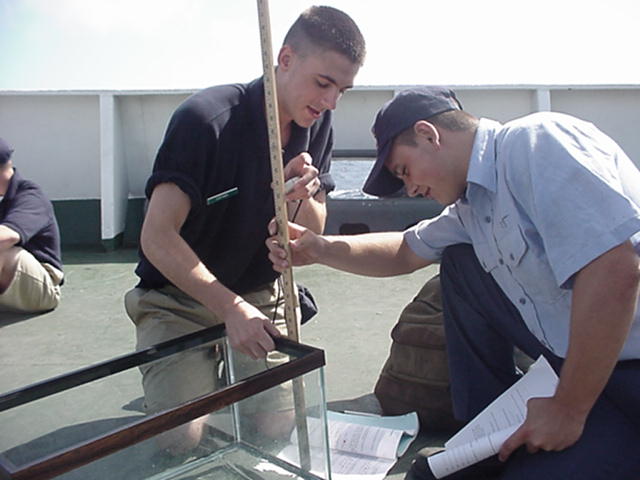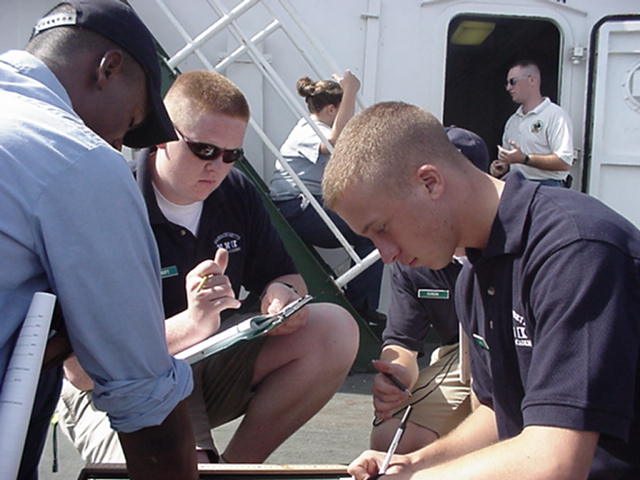
| February 2001 | ||||||
| Sun | Mon | Tue | Wed | Thu | Fri | Sat |
| 1 | 2 | 3 | ||||
| 4 | 5 | 6 | 7 | 8 | 9 | 10 |
| 11 | 12 | 13 | 14 | 15 | 16 | 17 |
| 18 | 19 | 20 | 21 | 22 | 23 | 24 |
| 25 | 26 | 27 | 28 | |||
At 0800 Eastern Standard Time, the Training Ship Empire State was located at 31 degrees and 12 minutes N Latitude, and 077 degrees and 38 minutes W Longitude. Savannah, Georgia was 280 nautical miles to the west. She was steering course 040 degrees true at a speed of 15 knots. The air temperature was 66 degrees and water temperature 72 degrees Fahrenheit; skies were partly cloudy; winds were from the southeast at 03 knots; barometric pressure was 1028 millibars and rising. Seas were 4 to 6 feet. Depth of water beneath the keel was 460 fathoms.
CAPTAIN'S LOG
There are no secrets to success: Don't waste time looking for them. Success is the result of perfection, hard work, learning from failure, loyalty to those for whom you work, and persistence.--Colin Powell, 1989
Well folks, we are in the Stream again and compared to this saltwater river, the Mississippi is a mere rivulet. We are taking full advantage of the Gulf Stream as its potent forces boosts the Empire State from the Southeastern coast of Florida, by the mid Atlantic States, and onward to Cape Cod. Many people, who live adjacent to this phenomenon, pay little attention to it and they fail to understand its importance. However, sailors know. Anyone who navigates through it for business or pleasure purposes quickly grasps the economics of it or pays dearly for ignorance.
The Gulf Stream beneath us moves along at a speed of one to four knots with a volume of 70,000,000 cubic meters per second! The Mississippi's volume is only about 20,000 cubic meters per second. Imagine, the volume of the Gulf Stream is 3500 times that of the Mississippi and greater than all the fresh water rivers in the world...combined!
What a training tank for our Crew Team! Imagine rowing against that current for a few hours. However, I feel certain that they are suffering sufficiently in Miami's training facility as we speak.
Guest writer, LT. Chris Kapp, Yarmouth, MA
Yesterday at 0900, twenty-five of our finest young men and women lowered themselves from this large and luxurious steam powered vessel onto a modern diesel powered tug. They are enroute to marine transportation of the painfully archaic kind: human power . That would be rowing shells.
Waiting for them ashore- the opportunity to row double sessions for eight days using equipment borrowed from the University of Miami. About the only things these young athletes took with them were duffel bags and backpacks filled with personal belongs, blister cream, ointment to soothe the aching backs, and of course, enormous resolve to make this Spring Season the best ever. They spoke of the Nationals as if their participation in them is simply an extension of the regular March to June season.
What motivates these cadets to row? Several young women that I spoke with said they had not been high school athletes but this is a different sport and they wanted to try it out. Others commented that rowing was not available in their high school but they learned that hard work can move one up in this sport so they went out for the team. Add a popular coach who keeps membership up and enthusiasm high and MMA has a winning combination. One senior smiled and commented: "The coach(Commander Fran McDonald) makes me row...I couldn't quit if I wanted to". Others mentioned the physical and mental rewards and the very competitive nature of the sport as reasons for making the effort. When one considers the daily campus routine, it becomes clear that motivation is a crucial ingredient necessary for team membership. Up at 0430 for 0500 practice that lasts for two hours, these student athletes put in a day's work before 0800.
The season has two parts: August to November and March to June. Remember what some of those early March or late November mornings are like? One has to admire the pluck and fortitude of these young people. The Spring season will feature "4's", that is, four seat shells. MMA has two four-seaters; a new shell named Flying Bridge and the older Engine Room. The races, called sprints, cover 2000 meters in the fastest times possible. This spring's competition will include races against UVM, Brandies, Middlebury, Roger Williams, and UMass. If the Nationals figure into the picture, challengers will include Michigan and Tulane. In the final assessment all agreed: "Crew is the most teamwork-oriented sport of all: you must stay in sync or everyone knows it".
Go Crew! Go Bucs!...Going Home!
Now they are away, aboard the Hvide tug "Broward" whose skipper took pleasure in announcing that the transfer was made possible by a graduate of MAINE Maritime Academy!
CADET COMMENTS
MSEP Lab on Waves, Cadet 1/C Dominic Catrambone

During their MSEP training period, fourth-class cadets learn that a wave's speed is dependent on the depth of the ocean and the density of the water. During waves lab, the cadets use aquariums with two different levels of water to differentiate between deepwater waves and shallow water waves. After raising and lowering the water levels in the tanks to predetermined heights, the cadets use stop watches to measure the time for the waves to do a lap of the tank. Then using algebra, they determine the speed of the waves in the shallow water tanks. For deepwater waves, cadets use eyedroppers to create ripples in the water and then measure the time it takes for these small waves to reach the other end of the fish tank. After data is collected, cadets calculate the speed of the deepwater waves. By doing two experiments, cadets gain a better understanding as to how waves move in the ocean and what elements are factors in their speed.

Expendable Bathy Thermographs (XBT), Cadet 2/C Katie Coan
The MSEP lab contains many things that freshmen can use to get a better idea of what the MSEP major is all about. One of them is using an XBT and observing and translating the resultant data. Expendable Bathy Thermographs or XBTs, are used by scientists to measure ocean depths and corresponding temperatures. When this zinc instrument is dropped into the ocean it relays information to the surface and to a specifically programmed computer. That program produces a line graph image of temperature versus depth. It makes the incoming information easier to comprehend.
Getting started with this equipment is easy. Placing the XBT in its holder completes an electrical circuit and simply pulling a pin releases the XBT to fall from its container. Two copper wires are paid out as the XBT falls. These wires carry information back to our computer. The XBT can decend to a depth of 760 meters, which is approximately one-half mile. Overall, the XBT lab is a great hands-on experience where freshman launch instruments and watch the information come to life. They are asked to locate the thermocline, which is the rapid change in temperature at a certain depth, and record the temperatures at different depths. XBT lab is interesting for everyone and it is made possible by the generous people at Sippican Ocean Systems of Marion, Massachusetts. They donated the XBTs.
QUESTIONS FOR WEDNESDAY 21 FEBRUARY
MATH:
The Empire state was traveling at a speed of 10 knots. Cadet Small reduced speed by 10 percent. Cadet Kearney assumed the watch and increased speed by 10 percent. At what speed was Empire State then traveling?
SCIENCE:
The earth rotates on its axis. Looking down at the earth from above the North Pole, does it spin clockwise or counterclockwise?
GEOGRAPHY:
The Confederate States of America came to be in 1861 when Abraham Lincoln was President. Name the Eleven Confederate States.
HISTORY:
Who was the President of the Confederate States and when was he Inaugurated?
ANSWERS FOR TUESDAY 20 FEBRUARY
MATH:
12/4 = 3 hours
12/6 = 2 hours
24miles/5 hours = 4.8 knots average speed.
SCIENCE:
Winter Solstice, Summer Solstice
22.5 degrees N Latitude and 22.5 degrees S Latitude
The earth is tilted at an angle of 23.5 degrees from the perpendicular.
GEOGRAPHY:
The first thirteen colonies of the United States are: Virginia, Massachusetts, Maryland, New York, Rhode Island, Connecticut, Delaware, New Hampshire, North Carolina, South Carolina, New Jersey, Pennsylvania and Georgia.
HISTORY:
President Washington was the First President and served from 1789-1797. - President Lincoln was the Sixteenth President from 1861-1865.